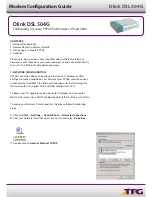
3G CDMA NIM/Cellular Interface
Configuring the 3G CDMA NIM Using the CLI
61700801G1-29.1H
Copyright © 2010 ADTRAN, Inc.
23
Interesting traffic is defined using the
ip access-list extended
<name>
command. The
ip access-list
extended
command is issued from the Global Configuration mode, and creates an empty ACL. The ACL
is used in conjunction with the demand routing interface to determine which traffic is deemed interesting
and will cause the demand interface to dial. When the
ip access-list extended
<name>
command is
entered, the extended access control list command set becomes accessible. In the extended access control
list command set, specify the action, protocol, source, and destination to be used for the ACL. To enter the
extended access control list command set, enter the
ip access-list extended
command as follows:
(config)#
ip access-list extended LOCAL_LAN_OUT
(config-ext-nacl)#
LOCAL_LAN_OUT is an example name, but serves to describe the type of ACL that will be used to
activate the demand routing interface. Once you have access to the extended access control list commands,
enter the
<action> <protocol> <source> <destination>
parameters to define traffic to be observed for
packet matching purposes. Enter the parameters as follows:
(config-ext-nacl)#
<action> <protocol> <source> <destination>
(config-ext-nacl)#
permit ip any any
In creating ACLs for cellular connection purposes, the action will be
permit
, the protocol will be
ip
, the
source will be
any
, and the keyword
any
will be specified so that attempted connection to any external IP
address will be deemed interesting.
Interesting traffic has now been defined, and the demand routing interface (once configured) will use
detection of the specified traffic to attempt to connect to the cellular network.
The
ip access-list extended
command has many uses not always associated with using the
demand routing interface to connect to a cellular network. The ACL examples in this
configuration guide are specific to using the ACLs for demand routing interface activation
and cellular connection. For more options and configurations of ACLs, refer to
Configuring IP ACLs in AOS
available online at
http://kb.adtran.com
(article number
3087).
















































